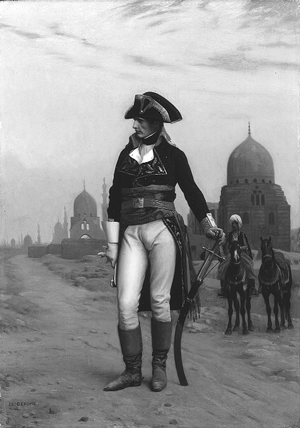Napoleon’s expropriation of an ancient culture
The notable French astronomer André Méchain, whose career spanned the French Revolution, said that when war divides peoples, art and science can serve to reunite them. This unusual and fascinating exhibition circles around Méchain’s claim while demonstrating, arguably, that modern democratic principles are deeply rooted in conflict, science, and art—or more precisely, symbolism based upon the visual culture of ancient civilizations.
Napoleon Bonaparte’s Egyptian campaign of 1798-1801 began when the young general set sail from France in 1798 with a fleet of 400 ships carrying some 55,000 soldiers and artist-technicians (known as “savants”). The expedition’s military objective—to block British trade with India—was inseparable from its scientific and artistic ambitions. Napoleon was bringing the French Revolution to Egypt, the better to annex it. Having set events in motion, however, he soon suffered defeat by the British, returned to France, and left the cultural mission in the hands of his soldiers and savants.
These young men, inspired by the ideals of the new France of the Revolution, mapped an area from Upper Egypt to the Nile’s vast delta and somewhat further north to Palestine’s borders. Along the way, they drew, catalogued, categorized, and ordered everything in sight.
What remains of Napoleon’s Egyptian campaign today is known as the “Déscription de L’Egypte.” This astounding series of engravings and color plates was conceived as a set of 20 volumes that collectors would acquire in installments—particularly since its completion dragged on long after Napoleon’s fall from power. The “Déscription” is said to be without parallel; yet earlier in the 18th century, in an almost unprecedented use of engravings, the French Encyclopedists systematically pictured and catalogued French culture. The possibility that the “Déscription” drew inspiration from the work of these pre-revolutionary savants is plausible.
In any case, after a century of amazing influence, the “Déscription” became hard to categorize from the point of view of cultural history and is rarely seen or heard of today. But it remains indelibly associated with the Napoleonic fervor for democracy, science and art. It initiated Egyptology as an art historical discipline. The symbolism of the eye-crowned pyramid on the reverse of the American one-dollar bill is based as much upon the symbolism of Napoleon’s “rediscovery” of Egypt as it is on other ideas from the ancient world.
Dahesh curator Lisa Small organized “Napoleon on the Nile” into five sections. They range from the savants’ imaginative reconstructions of ancient Egyptian ruins to natural history and topical renditions of life in then-modern Egypt. In contrast to the muted gray tones of engravings, watercolors of Egyptian flora and fauna are lavish. On other plates, richly colored copies of pictorial inscriptions and hieroglyphs were painstakingly recorded with no knowledge of what they meant, aside from a response to the beauty of the human figure. Mummified artifacts on view include the arm of a woman whose wrist bears a painted bracelet. Also of interest are rare letters from Napoleon to his commanders and scientists, dated according to a unique but short-lived time system developed by French Revolutionaries. Two or three colorful paintings in the exhibition were made later in the 19th century when Orientalist painting was in vogue. The inspiration for this style was based on, once again, the “Déscription de L’Egypte.”
The Dahesh Museum recently extended “Napoleon on the Nile” through the end of 2006 in order to coordinate with an exhibition at the Brooklyn Museum treating American collections of Egyptian artifacts. These 19th century collections were inspired by the “Déscription de L’Egypte” as well. Both institutions have cool, spacious galleries featuring specialized collections in art of the Middle East that deserve to be better known.
gaycitynews.com


































